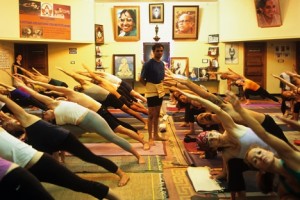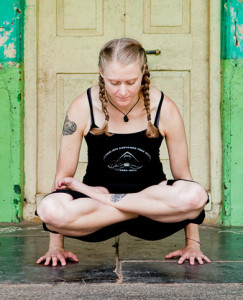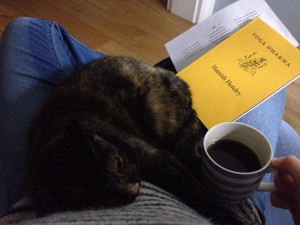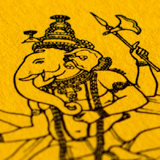It’s been almost 2 months since I returned from my second trip to Mysore and I can now say with certainty that the “Mysore magic” has seriously faded.
 What is this magic I speak of? If you’ve ever been to Mysore I’m sure you’ll know exactly what I mean. There’s just something so special about being in Mysore and practising at the KPJAYI (I can’t speak for anywhere else but maybe it’s the same at other shalas too.) Something about the community of like-minded Ashtangis from all over the world having very similar, if not exactly the same experiences as you; something about the heat and energy and all that wonderful prana being generated in the room; something about practising with around 80 other students of widely varying ages, nationality and levels of experience and commitment; something about Sharath’s presence and feeling him watching you, tuning in to you and adjusting you in a way that only he can.
What is this magic I speak of? If you’ve ever been to Mysore I’m sure you’ll know exactly what I mean. There’s just something so special about being in Mysore and practising at the KPJAYI (I can’t speak for anywhere else but maybe it’s the same at other shalas too.) Something about the community of like-minded Ashtangis from all over the world having very similar, if not exactly the same experiences as you; something about the heat and energy and all that wonderful prana being generated in the room; something about practising with around 80 other students of widely varying ages, nationality and levels of experience and commitment; something about Sharath’s presence and feeling him watching you, tuning in to you and adjusting you in a way that only he can.
Diving deeper
There’s just something about being in that shala that enables you to go deeper. Deeper into your practice, deeper into the postures, deeper into your heart and mind, deeper into yourself. Many students have talked and written about how they were able to do postures that previously seemed impossible, or about how their injuries miraculously disappeared or at least lessened once they started practising there.
But often I think it’s more subtle than that. I think it’s very easy to get settled into the rhythm and flow of daily practice and life in Mysore – especially after 2-3 months – and to take it for granted a certain amount. To forget what your practice was like back home. To forget about the responsibilities, the work, the pressures, even the weather, that all contribute to making daily practice that much more challenging back home.
What lies beneath
 Now I’m not saying life in Mysore is easy. It’s not, by any stretch of the imagination, particularly if you’ve brought work or studies with you, if you have your family in tow, or if you’re going through any kind of emotional or psychological struggle – which, let’s face it, most Ashtangis are! In my experience, this practice doesn’t attract people who are totally content with their lives, people who sail through life riding the waves on the surface and aren’t interested in looking at what might lie in the murky depths beneath.
Now I’m not saying life in Mysore is easy. It’s not, by any stretch of the imagination, particularly if you’ve brought work or studies with you, if you have your family in tow, or if you’re going through any kind of emotional or psychological struggle – which, let’s face it, most Ashtangis are! In my experience, this practice doesn’t attract people who are totally content with their lives, people who sail through life riding the waves on the surface and aren’t interested in looking at what might lie in the murky depths beneath.
In my experience, the people who come to this practice (or is it the practice that comes to them?), are those who have been through many struggles in their lives, have perhaps dealt with anxiety, depression, addiction or any number of physical conditions or disease, or are simply searching for something more. Something more meaningful, something that allows more exploration, something that might provide some answers, or at least help to start asking the right questions. But that’s another whole blog topic in itself… 😉
Bursting the bubble
Ok, so life in Mysore isn’t necessarily easy. But it is magical. And, for me, I definitely brought some of this magic home with me. I returned to the UK in January – probably the worst month to return to the UK from a hot country! Everyone said the winter had been very mild so far, but that quickly changed. The wind howled, the rain poured and storms they were a-brewing. But I didn’t mind, not one bit.
 I was flat-sitting for a friend the first 10 days and I was so happy in my cosy little nest by the seafront. I was sleeping like a baby, waking with ease at the 4:45am alarm call, enjoying a bit of chanting while sipping my morning coffee, walking half an hour to the shala (in the dark, cold & sometimes heavy rain remember), getting on my mat and experiencing the lightest, strongest and most energetic practices I’ve probably ever experienced in this country. My body felt so light and open, and I was definitely still in the Mysore bubble.
I was flat-sitting for a friend the first 10 days and I was so happy in my cosy little nest by the seafront. I was sleeping like a baby, waking with ease at the 4:45am alarm call, enjoying a bit of chanting while sipping my morning coffee, walking half an hour to the shala (in the dark, cold & sometimes heavy rain remember), getting on my mat and experiencing the lightest, strongest and most energetic practices I’ve probably ever experienced in this country. My body felt so light and open, and I was definitely still in the Mysore bubble.
But eventually the bubble has to burst. Well, maybe it doesn’t have to, but it did for me. It was very gradual though, so more of a slow puncture than a sudden burst. Looking back at how I felt then, I realise what a big difference 2 months has made. Now I’m struggling to get up in the mornings, I feel heavier, with less energy, and I can feel my body starting to close up again. Some days aren’t so bad, but the morning of writing this post sure was. Very bad in fact. I felt like my batteries had run out. I had one of those mornings when I just couldn’t get out of bed and toyed with the idea of not going at all. But I made myself get up, knowing that I often feel ok once I get on the mat. But not today. Oh boy.
It’s all in the mind
I kept telling myself I just had to get through it, which isn’t exactly the ideal attitude to be practising with in the first place, right? But my teacher’s always saying the most important practices with the deepest transformation are the ones when you don’t feel like it but you do it anyway. Today I beg to differ. Today I think I should have just stayed in bed. I felt like a sack of potatoes on the mat and was dragging my limp limbs around, only to end up a tear-strewn mess in the toilet. I tried to stop feeling sorry for myself and carry on, but it was no use. Attempting Kapotasana was the breaking point and I just had to give in.
My teacher says it’s all in the mind and you just have to overcome your thoughts. I agree with that to a certain extent, but sometimes it’s also in your body! Although, as Fiona Stang of Ashtanga Yoga Vancouver shares in this video, it’s definitely all about the mindset. Her no-nonsense inspiring words make me glad I got to practice today and I’ll definitely try to remember them next time I’m having a bad yoga morning!
Virtuosity vs hedonism
 I can feel myself slipping back into wanting to feel a bit more “normal”. The great thing about being in Mysore is everyone is there for the same reason. Everyone gets up at stupid-o-clock to do their practice, everyone celebrates moon days and no-one stays out late drinking and being hedonistic. Well, rarely anyway. But back home I’m the odd one out. And although I kinda like this sometimes, I feel like I’m often saying no to invitations and ‘depriving’ myself of ‘normal’ pleasures. Like a glass of wine during the week, or staying up late just for the hell of it. Or, heaven forbid, going out and getting absolutely trashed and just seeing where the night takes me!
I can feel myself slipping back into wanting to feel a bit more “normal”. The great thing about being in Mysore is everyone is there for the same reason. Everyone gets up at stupid-o-clock to do their practice, everyone celebrates moon days and no-one stays out late drinking and being hedonistic. Well, rarely anyway. But back home I’m the odd one out. And although I kinda like this sometimes, I feel like I’m often saying no to invitations and ‘depriving’ myself of ‘normal’ pleasures. Like a glass of wine during the week, or staying up late just for the hell of it. Or, heaven forbid, going out and getting absolutely trashed and just seeing where the night takes me!
I’m also aware of feeling the need to ‘treat’ myself a little too often. My thinking goes something like ‘I get up every day at the crack of dawn, when everyone else is seeping, to do a physically intense practice, which means I go to bed early, which means I eat early, which means I can’t do anything else in the evenings. Every day, day in, day out. Surely I deserve a little reward every now and then…..? Or even every day…..?’
Yoga comes and yoga goes
Something Hamish Hendry wrote in his new book, Yoga Dharma, struck a chord with me on this subject. It’s the bit where he’s summarising the Katha Upanishad (p.24), and shares two verses that he always keeps in mind:
 “There is the path of joy and the path of pleasure. Both are attractive. Who follows the first comes to virtue. For those that follow pleasure there is no end. (2.1)”
“There is the path of joy and the path of pleasure. Both are attractive. Who follows the first comes to virtue. For those that follow pleasure there is no end. (2.1)”
and
“The calm steadiness of the senses is called yoga. But we should be watchful because yoga comes and yoga goes. (6.11)”
So I guess I need to find a way to bring more joy into my life without seeking hedonistic pleasure. Perhaps I need to be a little less hard on myself. And learn to play more (without the need for alcohol). And I also need to be aware of those times when I can feel the yoga gently slipping away. When I can feel myself becoming slightly less connected, slightly less ‘tapped in’, to the global Ashtanga community, to the practice, to Sharath’s teachings, to the magic of Mysore.
And maybe the bubble hasn’t totally burst. Maybe it’s just quietly resting, deflated, beneath the surface, waiting for another injection of Mysore magic to expand it to its beautiful, majestic, miraculous self again. I guess only time will tell…
– Hannah
Have you experienced the Mysore magic?
What about losing it again after returning home? How did you cope? We’d love to hear from you, so do share your experiences and insights in the comments section below.

I returned home from my first trip to Mysore November 2014. It is now March 2015 and I can feel the bubble has burst and rebuilt itself and then burst and rebuilt and burst again.
I can relate to almost everything you said.. Especially being the “odd one out”. I’m 23 and people my age tend to stay up and go out, whereas I choose to be in bed so that I can wake up early and do my practice. It has become important to me and o barely feel left out because I know that I am doing this for a greater purpose within myself (that being said it does NOT make you “above” anyone who chooses a different lifestyle).
I find that some days I can do a full primary for the whole week and then the next week I can barely get though standing. At first I found it frustrating but slowly I see that it is all part of the process.
Clint at EkamInhale has a great email that you can subscribe to and it has helped me a lot lately since I have “lost” a great number of my postures due to heaviness. Fatigue, and not having enough time in the morning because of Western life and responsibilities that you get to let go of when in India. I wrote to him one day with a long winded explanation of my practice and how it’s not as strong and all he replied with was “consistency over quantity” and those words have been stuck in my head ever since.
Hi Gina, thanks for sharing, I think this is a very common occurrence and it’s interesting to hear about your bubble bursting over and over again, I wonder if I’ll have the same experience… Yes this process is certainly fascinating and seems to teach us more and more the longer we stay with it. The Ekaminhale posts are great. I know Clint and am also subscribed to his email feed. Consistency over quantity – amen to that! Although sometimes it’s harder said than done so it’s great to keep reminding ourselves. Consistency over quantity, consistency over quantity… 😉 Hannah x
The Mysore magic bubble does ebb away, Ive been back two weeks now and spent half that time in hospital, i had been hoping to keep that Mysore level of practice and energy going.
Back in the real world of work, family and other commitments its almost impossible to stay in the wonderful physical and mental bubble we experience in Mysore.
Hi Kevin, thanks for sharing. It’s reassuring to know other people experience it too. I guess everything that happens along the path is a reminder of our personal journey and where we need to focus our attention. Sorry to hear you’ve been in hospital, wishing you a speedy recovery back to full health x
Hi Hannah,
your article brought a smile to my face when I read the bit about enjoying the normal things, staying up late and the odd glass of wine, which are really out of the question when you want to do an early practice. I’ve never been to Mysore, yet, but the consistent practice is something I am still grappling with. I feel I am just to the point of committing every day. Some weeks, yes, no problem, the next week, I question my sanity and wonder is it just an addiction that I swapped for an earlier one that I had in my life. But the contentment it brings me and the steadiness in life, is why I practice, and probably that is why we all practice, and not to get onto FB and see what pose I can do. My view has always been that our practice is really off the mat.
I want to commend you on your article and that little quote by Hamish brought it all into place.
Thank you.
David Johnston
Hi David, thanks for your comments and kind words. Yes I’m sure we’ve all experienced this at some point along the way – and many of us still do. Your comment about swapping one addiction for another is interesting, and a topic that’s come up in many yogic discussions. There can be a fine line between addiction/obsession and dedication/commitment and I think it’s often a challenge to find that balance within our practice. And you’re so right about our practice really being off the mat – another great reminder. Thanks again and good luck with your journey, Hannah x
I love the Fiona Stang YouTube, it inspires me to get on my mat and not worry about it being good or bad,,it’s just about showing up.
I agree with you all about Clint’s Ekaminhale posts, he asked me to do an interview for him while I was in Mysore, I’m looking forward to seeing the edited version
Hi Kevin, yes it’s a great video. That’s exciting, I look forward to seeing your interview too!
This has helped me:
“One who outwardly performs his social duties but inwardly stays free is a yogi”.
Bhagavad Gita
Hi Robert. Thanks, that’s a great quote and a wonderful reminder. Now we just have to work out how to remain inwardly free!
Hi Hannah,
Nice post thankyou. I do agree it’s tough coming back…in winter especially. The balmy walks (or scooter rides) to the shala replaced by bitter cold and tube journeys to practice.
It’s been my first full winter at home for a fair few years and while I love Mysore the journey adventure, familiarity, people etc. I’ve felt a relief from not going this year, interrupting my life and unsettling myself.
I also think it depends what your coming back to…a lot of the time we have ‘stuff’up in the air when we return home and again, it’s reality…and a very different one to what we’ve been living for the past 1-3 months. Perhaps it’s the unsteadiness that is challenging?
With regard to being the odd one out…well yes, it is odd, it’s a strange life choice for sure. And that’s probably one reason we keep going back to Mysore to fit in, be with ‘our tribe’. Be understood. Saying that…what’s wrong with a glass of wine in the week every now and again?! And a day off when your exhausted? Has to be a balance.
I hope your hitting your uk stride again 🙂
Soph x
Hi Sophie, thanks for sharing. It’s interesting that you’ve found it a relief not going to Mysore this year, but I totally understand what you mean. And, yes, it really does depend what you’re coming back to and what’s going on in your life. I think if you’re someone who’s able to make the trip to Mysore every year that pretty much indicates that you don’t have a ‘normal’ 9-5 job anyway. But it may then follow that you’re often between things, or don’t have guaranteed work to come back to, or possibly not even a solid base to come back to – all of which I’ve experienced this time, and yes it is challenging! I agree, balance is the key. And not being too rigid. There might be a blog post about that coming soon…! Thanks again Sophie, take care x
Hannah, thank you for your post. These low moments seem to come and go, but while they happen, during those days or weeks of crying on your mat (!) you lose perspective.
Yes that’s true Saija, that’s another challenge we all face – maintaining both balance and perspective!